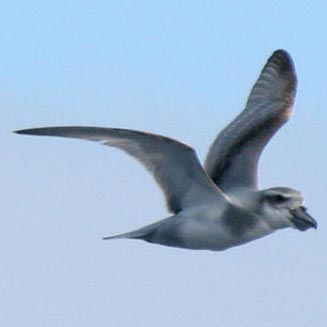|
Pachyptila vittata (Broad-billed
prion)
BreŽbekwalvisvoŽl [Afrikaans]; Breedbekprion [Dutch];
Prion de Forster [French]; Entensturmvogel und Taubensturmvogel [German];
Painho-filtrador-de-bico-largo [Portuguese]
Life
> Eukaryotes >
Opisthokonta
> Metazoa (animals) >
Bilateria >
Deuterostomia > Chordata >
Craniata > Vertebrata (vertebrates) > Gnathostomata (jawed
vertebrates) > Teleostomi (teleost fish) > Osteichthyes (bony fish) > Class:
Sarcopterygii (lobe-finned
fish) > Stegocephalia (terrestrial
vertebrates) > Tetrapoda
(four-legged vertebrates) > Reptiliomorpha > Amniota >
Reptilia (reptiles) >
Romeriida > Diapsida > Archosauromorpha > Archosauria >
Dinosauria
(dinosaurs) > Saurischia > Theropoda (bipedal predatory dinosaurs) >
Coelurosauria > Maniraptora > Aves
(birds) > Order: Ciconiiformes
> Family: Procellariidae
 |
|
|
Broad-billed prion, offshore from New Zealand.
[photo Simon Tan
©] |
|
Distribution and habitat
Breeds on Tristan da Cunha, Gough Island and islands off
New Zealand, after which it disperses across the southern oceans. It is rare
vagrant to southern Africa, with a few records of stranded birds on the coast of
the Western Cape and central Mozambique, as well as at sea in the south-western
corner of the region.
Food
It mainly eats small crustaceans by filtering them through
its serrated bill, or alternatively grabbing large prey, such as fish and squid,
from the water surface.
Threats
Not threatened, with an estimated global population of at
least six million individuals.
References
-
Hockey PAR, Dean WRJ and Ryan PG 2005. Roberts
- Birds of southern Africa, VIIth ed. The Trustees of the John Voelcker
Bird Book Fund, Cape Town.
|
